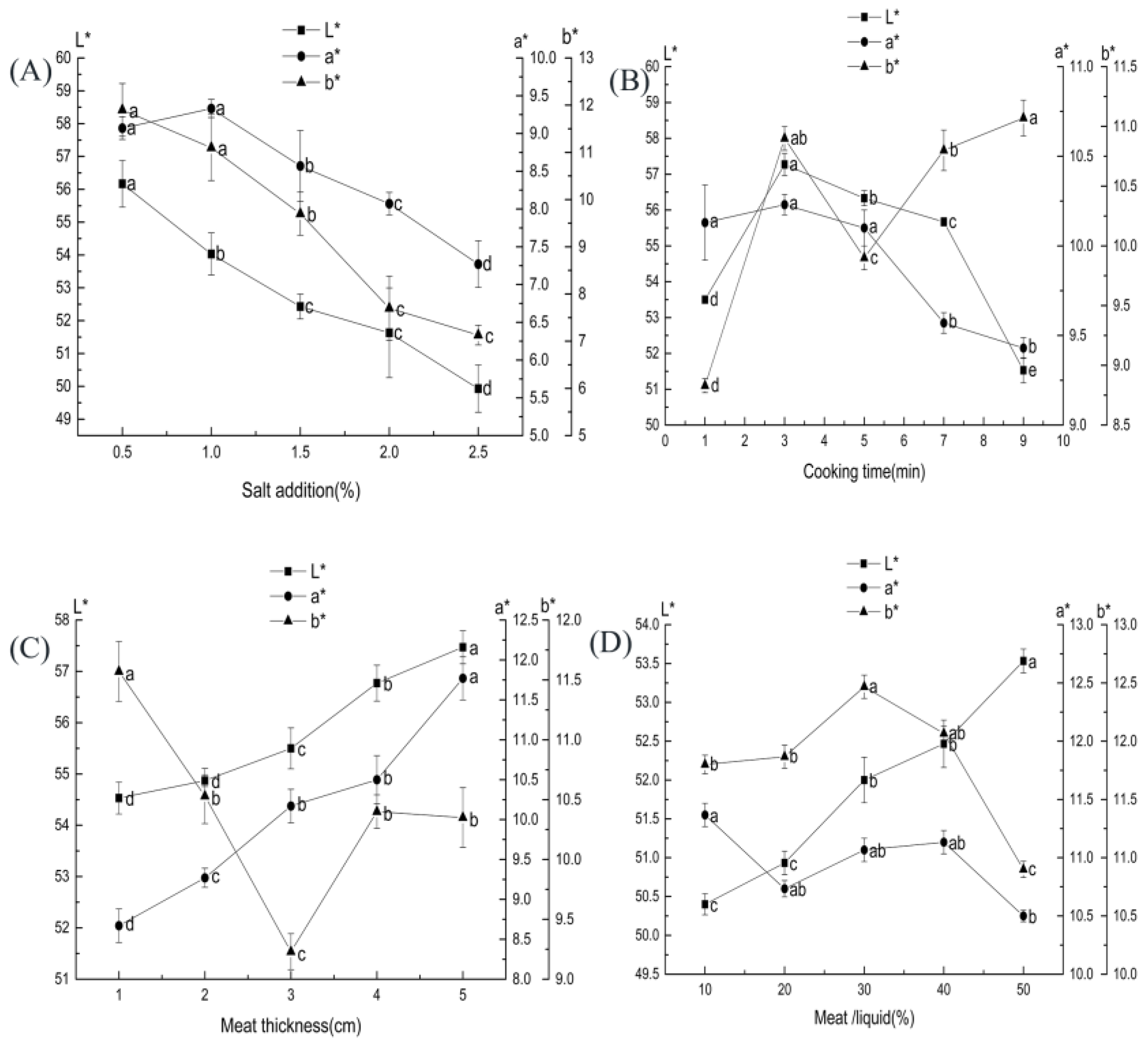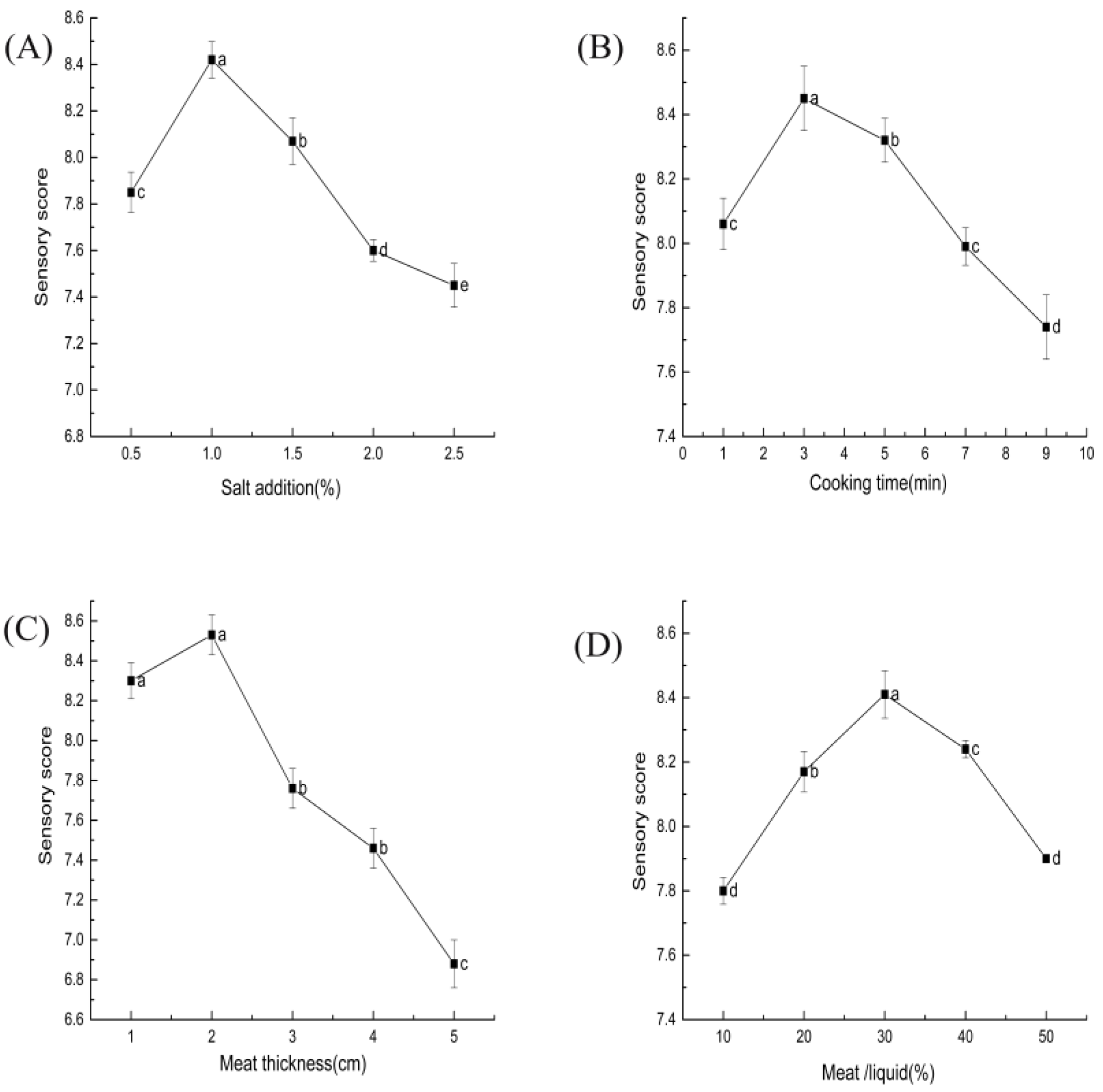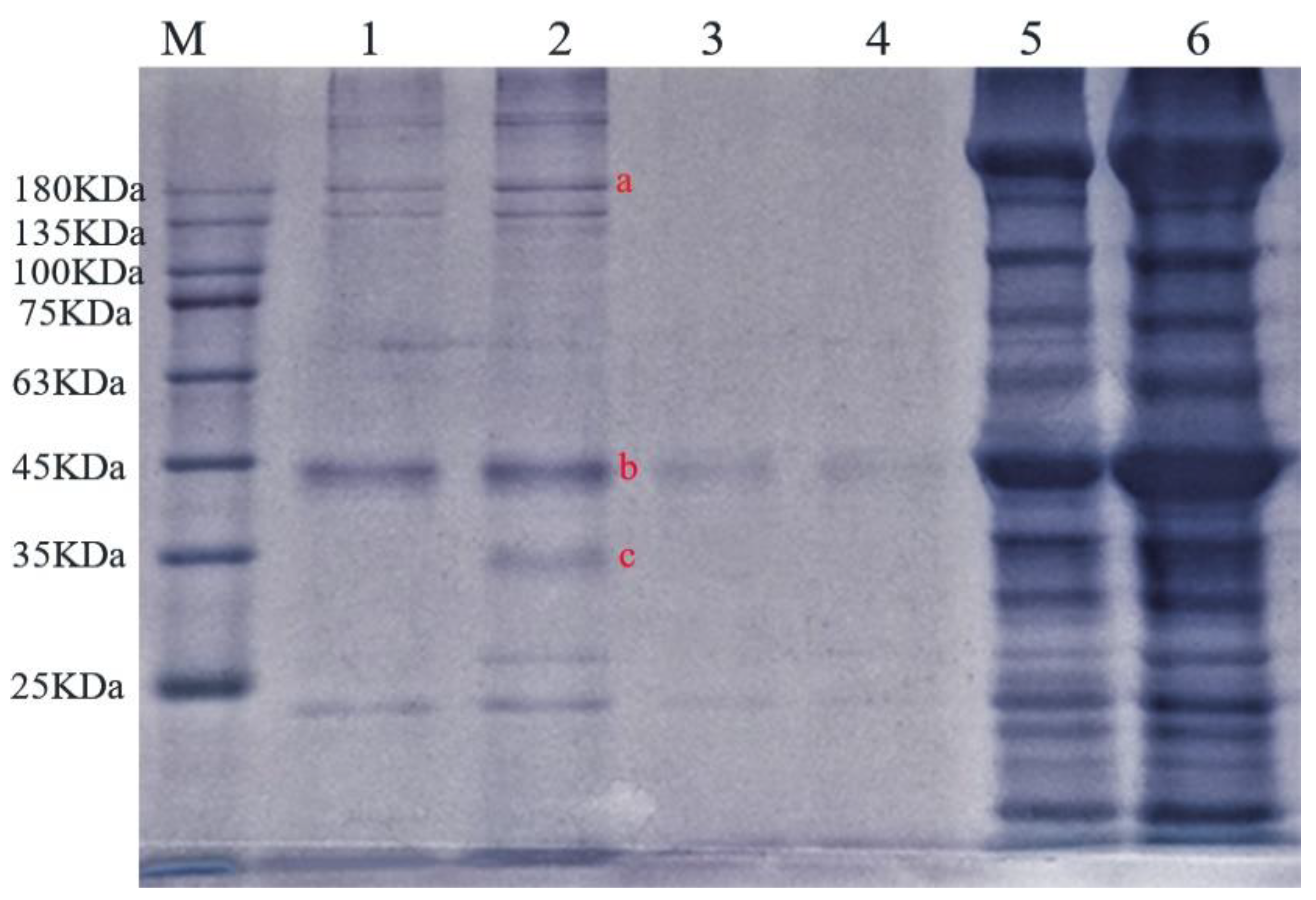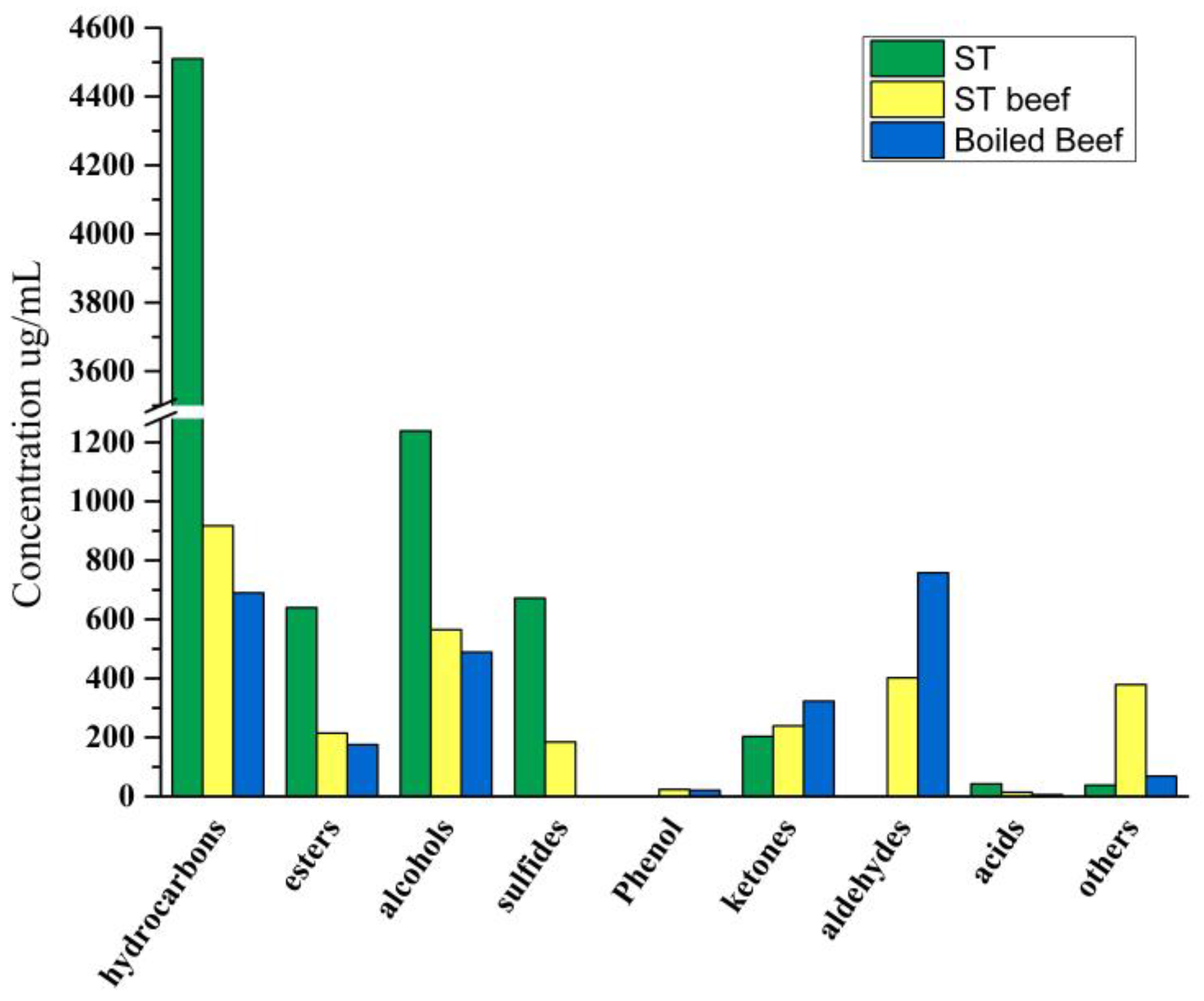Effects of Process Parameters on the Quality of Suantang Beef
Abstract
1. Introduction
2. Materials and Methods
2.1. Processing of Beef Samples and ST
2.2. Orthogonal Analysis
2.3. Yield
2.4. Color Measurement in CIE System
2.5. Water Content, pH, and Texture Determination
2.6. Sensory Evaluation
2.7. Extraction and Activity Determination of Cathepsin L
2.8. Analysis of the Protein Composition
2.9. Volatile Profile Analysis via HS-SPME Combined with GC-MS
2.10. Statistical Analysis
3. Results and Discussion
3.1. Effect of Salt Addition on the Quality of ST Beef
3.2. Effect of Cooking Time on the Quality of ST Beef
3.3. Effect of Meat Thickness on the Quality of ST Beef
3.4. Effect of Beef–ST Ratio on the Quality of ST Beef
3.5. Effect of Beef–ST Ratio on the Quality of ST Beef
3.6. Quality Analysis of ST Beef and Boiled Beef
3.6.1. Physical and Chemical Qualities of ST Beef and Boiled Beef
3.6.2. Protein Composition and SDS-PAGE of ST Beef and Boiled Beef
3.6.3. Volatile Compounds in ST Beef and Boiled Beef
4. Conclusions
Supplementary Materials
Author Contributions
Funding
Institutional Review Board Statement
Informed Consent Statement
Data Availability Statement
Conflicts of Interest
References
- Wang, C.; Song, X.; Li, C.; He, L.; Wang, X.; Zeng, X. Mixed fermentation with Lactobacillus plantarum, Bifidobacteriµm animalis subsp. lactis and Candida utilis improves the fermentation quality of Hong Suan Tang. Food Chem. 2022, 134488. [Google Scholar] [CrossRef] [PubMed]
- Wang, C.; Zhang, Q.; He, L.; Li, C. Determination of the microbial communities of Guizhou Suantang, a traditional Chinese fermented sour soup, and correlation between the identified microorganisms and volatile compounds. Food Res. Int. 2020, 138, 109820. [Google Scholar] [CrossRef] [PubMed]
- Zeng, R.; Han, L.; Huang, P. Research progress and industrialization of hot pot seasoning in Guizhou red sour soup. Food Ferment. Technol. 2014, 50, 72–75. (In Chinese) [Google Scholar]
- Pan, J.; Qing, L.; Wen, A.; Yang, Z.; Liu, N. Analysis of nutritional quality and taste characteristics of Guizhou red acid soup. China Condiment 2020, 45, 43–48+53. (In Chinese) [Google Scholar]
- Simone, E.; Alan, C.; Mridula, C. Lycopene treatment of prostate cancer cell lines inhibits adhesion and migration properties of the cells. Int. J. Med. Sci. 2014, 11, 948. [Google Scholar] [CrossRef][Green Version]
- Pan, H. Research on the Drying Process of Red Sour Soup and the Quality of Cooking Meat Food. Master’s Thesis, Guizhou University, Guiyang, China, 2020. (In Chinese). [Google Scholar]
- Al-Dalali, S.; Li, C.; Xu, B. Effect of frozen storage on the lipid oxidation, protein oxidation, and flavor profile of marinated raw beef meat. Food Chem. 2022, 376, 131881. [Google Scholar] [CrossRef]
- Castillo, C.; Benedito, J.L.; Hernández, J. The authentic nutritional value of beef: Remove false assumptions. Res. Vet. Sci. 2019, 125, 119–120. [Google Scholar] [CrossRef]
- Zhou, Y.; Zhang, Y.; Pang, G.; Wang, S. Effect of inoculation of starter on physicochemical properties and texture characteristics of fermented beef jerky. J. Food Process. Preserv. 2021, 45, e15744. [Google Scholar] [CrossRef]
- Wall, K.R.; Kerth, C.R.; Miller, R.K.; Alvarado, C. Grilling temperature effects on tenderness, juiciness, flavor and volatile aroma compounds of aged ribeye, strip loin, and top sirloin steaks. Meat Sci. 2019, 150, 141–148. [Google Scholar] [CrossRef]
- Rodrigues, I.; Trindade, M.A.; Caramit, F.R.; Candoğan, K.; Pokhrel, P.R.; Barbosa-Cánovas, G.V. Effect of high pressure processing on physicochemical and microbiological properties of marinated beef with reduced sodium content. Innov. Food Sci. Emerg. Technol. 2016, 38, 328–333. [Google Scholar] [CrossRef]
- Mottram, D.S. Flavour formation in meat and meat products: A review. Food Chem. 1998, 62, 415–424. [Google Scholar] [CrossRef]
- Cao, G.; Li, K.; Guo, J.; Lu, M.; Hong, Y.; Cai, Z. Mass spectrometry for analysis of changes during food storage and processing. J. Agric. Food Chem. 2020, 68, 6956–6966. [Google Scholar] [CrossRef] [PubMed]
- Bueno, M.; Resconi, V.C.; Campo, M.M.; Ferreira, V.; Escudero, A. Development of a robust HS-SPME-GC-MS method for the analysis of solid food samples. Analysis of volatile compounds in fresh raw beef of differing lipid oxidation degrees. Food Chem. 2019, 281, 49–56. [Google Scholar] [CrossRef] [PubMed]
- Ma, Q.L.; Hamid, N.; Bekhit, A.E.D.; Robertson, J.; Law, T.F. Optimization of headspace solid phase microextraction (HS-SPME) for gas chromatography mass spectrometry (GC–MS) analysis of aroma compounds in cooked beef using response surface methodology. Microchem. J. 2013, 111, 16–24. [Google Scholar] [CrossRef]
- Li, H.; Geng, W.; Haruna, S.A.; Zhou, C.; Wang, Y.; Ouyang, Q.; Chen, Q. Identification of characteristic volatiles and metabolomic pathway during pork storage using HS-SPME-GC/MS coupled with multivariate analysis. Food Chem. 2022, 373, 131431. [Google Scholar] [CrossRef]
- Xu, Y.; Zhang, D.; Chen, R.; Yang, X.; Liu, H.; Wang, Z.; Hui, T. Comprehensive evaluation of flavor in charcoal and electric-roasted tamarix lamb by HS-SPME/GC-MS combined with electronic tongue and electronic nose. Foods 2021, 10, 2676. [Google Scholar] [CrossRef]
- Gök, V.; Akkaya, L.; Obuz, E.; Bulut, S. Effect of ground poppy seed as a fat replacer on meat burgers. Meat Sci. 2011, 89, 400–404. [Google Scholar] [CrossRef]
- Wang, B.; Li, F.; Pan, N.; Kong, B.; Xia, X. Effect of ice structuring protein on the quality of quick-frozen patties subjected to multiple freeze-thaw cycles. Meat Sci. 2021, 172, 108335. [Google Scholar] [CrossRef]
- Abdallah, M.R.S.; Mohmaed, M.A.; Mohamed, H.M.H.; Emara, M.M.T. Improving the sensory, physicochemical and microbiological quality of pastirma (A traditional dry cured meat product) using chitosan coating. LWT Food Sci. Technol. 2017, 86, 247–253. [Google Scholar] [CrossRef]
- Cui, B.; Guo, X.; Zhang, Y.; Meng, X. Effect of lysosomal cathepsin L on proteolysis of beef myofibrillar proteins in vivo and in vitro. Foods 2022, 11, 613. [Google Scholar] [CrossRef]
- Tang, X.; Zhen, H.; Zhang, C.; Zheng, J.; Zhang, J. Protein composition analysis and molecular weight distribution of clams. Food Sci. Technol. 2015, 36, 362–366. [Google Scholar] [CrossRef]
- Siddiqi, R.A.; Singh, T.P.; Rani, M.; Sogi, D.S.; Bhat, M.A. Diversity in grain, flour, amino acid composition, protein profiling, and proportion of total flour proteins of different wheat cultivars of North India. Front. Nutr. 2020, 7, 141. [Google Scholar] [CrossRef] [PubMed]
- Wang, C.; Liu, H.; He, L.; Li, C. Determination of bacterial community and its correlation to volatile compounds in Guizhou Niuganba, a traditional Chinese fermented dry-cured beef. LWT Food Sci. Technol. 2022, 161, 113380. [Google Scholar] [CrossRef]
- Zhou, X.; Chong, Y.; Ding, Y.; Gu, S.; Liu, L. Determination of the effects of different washing processes on aroma characteristics in silver carp mince by MMSE-GC-MS, e-nose and sensory evaluation. Food Chem. 2016, 207, 205–213. [Google Scholar] [CrossRef]
- Gemert, L.J.V. Odour Thresholds: Compilations of Odour Threshold Values in Air, Water and Other Media (Edition 2011); Oliemans Punter & Partners BV: Zeist, The Netherlands, 2011. [Google Scholar]
- Nguyen, M.V.; Thorarinsdottir, K.A.; Gudmundsdottir, A.; Thorkelsson, G.; Arason, S. The effects of salt concentration on conformational changes in cod (Gadus morhua) proteins during brine salting. Food Chem. 2011, 125, 1013–1019. [Google Scholar] [CrossRef]
- Horita, C.N.; Messias, V.C.; Morgano, M.A.; Hayakawa, F.M.; Pollonio, M.A.R. Textural, microstructural and sensory properties of reduced sodium frankfurter sausages containing mechanically deboned poultry meat and blends of chloride salts. Food Res. Int. 2014, 66, 29–35. [Google Scholar] [CrossRef]
- Lopez, K.; Schilling, M.W.; Armstrong, T.W.; Smith, B.S.; Corzo, A.C. Sodium chloride concentration affects yield, quality, and sensory acceptability of vacuum-tumbled marinated broiler breast fillets. Poult. Sci. 2012, 91, 1186–1194. [Google Scholar] [CrossRef]
- Conroy, P.M.; O’Sullivan, M.G.; Hamill, R.M.; Kerry, J.P. Sensory optimisation of salt-reduced corned beef for different consumer segments. Meat Sci. 2019, 154, 1–10. [Google Scholar] [CrossRef]
- Hutton, T. Sodium technological functions of salt in the manufacturing of food and drink products. Br. Food J. 2002, 104, 126–152. [Google Scholar] [CrossRef]
- Uzakov, Y.M.; Kaimbayeva, L.A.; Dikhanbayeva, F.T.; Koshoeva, T.R.; Smailova, Z.Z. Physicochemical parametres of yak meat during massaging and salt pickling. J. AOAC Int. 2021, 105, 822–826. [Google Scholar] [CrossRef]
- Vasquez Mejia, S.M.; Shaheen, A.; Zhou, Z.; McNeill, D.; Bohrer, B.M. The effect of specialty salts on cooking loss, texture properties, and instrumental color of beef emulsion modeling systems. Meat Sci. 2019, 156, 85–92. [Google Scholar] [CrossRef] [PubMed]
- Nie, X.; Liu, H.; Yu, N.; Tang, Q.; Wu, C.; Meng, X. Effect of high pressure homogenization on aggregation, conformation, and interfacial properties of bighead carp myofibrillar protein. J. Food Sci. 2021, 86, 5318–5328. [Google Scholar] [CrossRef] [PubMed]
- Purslow, P.P.; Oiseth, S.; Hughes, J.; Warner, R.D. The structural basis of cooking loss in beef: Variations with temperature and ageing. Food Res. Int. 2016, 89, 739–748. [Google Scholar] [CrossRef] [PubMed]
- Tian, X.; Wu, W.; Yu, Q.; Hou, M.; Jia, F.; Li, X.; Dai, R. Quality and proteome changes of beef M. longissimus dorsi cooked using a water bath and ohmic heating process. Innov. Food Sci. Emerg. Technol. 2016, 34, 259–266. [Google Scholar] [CrossRef]
- Tian, X.; He, H.; Jie, X.; Chen, Y.; Chen, P.; Zhang, J. Effects of different cooking times on pork quality and nutritional composition. Meat Ind. 2018, 46, 25–29. [Google Scholar] [CrossRef]
- Cauble, R.N.; Ball, J.J.; Zorn, V.E.; Reyes, T.M.; Wagoner, M.P.; Coursen, M.M.; Lambert, B.D.; Apple, J.K.; Sawyer, J.T. Characteristics of pork muscles cooked to varying end-point temperatures. Foods 2021, 10, 2963. [Google Scholar] [CrossRef]
- Peng, Z.; Liu, S.; Deng, C. Process optimization of beef with sous-vide cooking sauce. Gastron. Res. 2020, 37, 48–52. [Google Scholar]
- Gurikar, A.M.; Lakshmanan, V.; Gadekar, Y.P.; Sharma, B.D.; Anjaneyulu, A.S.R. Effect of meat chunk size, massaging time and cooking time on quality of restructured pork blocks. Int. J. Food Sci. Technol. 2012, 51, 1363–1369. [Google Scholar] [CrossRef]
- Jantaranikorn, M.; Yongsawatdigul, J. Effect of marinating ingredients on temperature-induced denaturation of hemoglobin and its relation to red blood spot formation in cooked chicken breast. J. Food Sci. 2020, 85, 2398–2405. [Google Scholar] [CrossRef]
- Bakhsh, A.; Lee, S.-J.; Lee, E.-Y.; Sabikun, N.; Hwang, Y.-H.; Joo, S.-T. A novel approach for tuning the physicochemical, textural, and sensory characteristics of plant-based meat analogs with different levels of methylcellulose concentration. Foods 2021, 10, 560. [Google Scholar] [CrossRef]
- Tang, C.; Huang, M.; Fan, J.; Zhou, G. Optimize the process of kneading and marinating duck breast products (in Chinese). Food Sci. 2013, 34, 63–67. [Google Scholar]
- Lan, H.; Liu, H.; Ye, Y.; Yin, Z. The role of surface properties on protein aggregation behavior in aqueous solution of different pH values. J. Am. Pharm. Assoc. 2020, 21, 122. [Google Scholar] [CrossRef] [PubMed]
- Shen, J.D.; Cai, Q.F.; Yan, L.J.; Du, C.H.; Liu, G.M.; Su, W.J.; Ke, C.; Cao, M.J. Cathepsin L is an immune-related protein in pacific abalone (haliotis discus hannai)--purification and characterization. Fish Shellfish Immunol. 2015, 47, 986–995. [Google Scholar] [CrossRef] [PubMed]
- Visessanguan, W.; Benjakul, S.; Riebroy, S.; Thepkasikul, P. Changes in composition and functional properties of proteins and their contributions to Nham characteristics. Meat Sci. 2004, 66, 579–588. [Google Scholar] [CrossRef]
- Shi, Y.; Li, X.; Huang, A. Multivariate analysis approach for assessing coated dry-cured ham flavor quality during long-term storage. J. Food Sci. Technol. 2021, 58, 651–659. [Google Scholar] [CrossRef]
- Zou, Y.; Kang, D.; Liu, R.; Qi, J.; Zhou, G.; Zhang, W. Effects of ultrasonic assisted cooking on the chemical profiles of taste and flavor of spiced beef. Ultrason. Sonochem. 2018, 46, 36–45. [Google Scholar] [CrossRef]
- Ventanas, S.; Mustonen, S.; Puolanne, E.; Tuorila, H. Odour and flavour perception in flavoured model systems: Influence of sodium chloride, umami compounds and serving temperature. Food Qual. Prefer. 2010, 21, 453–462. [Google Scholar] [CrossRef]
- Li, H.; Li, X.; Zhang, C.-H.; Wang, J.-Z.; Tang, C.-H.; Chen, L.-L. Flavor compounds and sensory profiles of a novel Chinese marinated chicken. J. Sci. Food Agric. 2016, 96, 1618–1626. [Google Scholar] [CrossRef]
- Buck, N.; Wohlt, D.; Winter, A.R.; Ortner, E. Aroma-active compounds in robusta coffee pulp puree-evaluation of physicochemical and sensory properties. Molecules 2021, 26, 3925. [Google Scholar] [CrossRef]
- Larsen, M.; Poll, L. Odour thresholds of some important aroma compounds in strawberries. Z. Lebensm.-Unters. Forsch. 1992, 195, 120–123. [Google Scholar] [CrossRef]
- Li, R.; Geng, C.; Xiong, Z.; Cui, Y.; Liao, E.; Peng, L.; Jin, W.; Wang, H. Evaluation of protein degradation and flavor compounds during the processing of Xuan’en ham. J. Food Sci. 2022, 87, 3366–3385. [Google Scholar] [CrossRef] [PubMed]
- Belitz, H.-D.; Grosch, W.; Schieberle, P. (Eds.) Cereals and Cereal Products. In Food Chemistry; Springer: Berlin/Heidelberg, Germany, 2009; pp. 670–745. [Google Scholar]
- Rode, H.R.; Fehrman, C.E.; Blair, A.D.; Underwood, K.R.; Zuelly, S.M.S. Evaluation of the significance of the maillard browning reaction, caramelization, and flavor development in beef steaks. Meat Sci. 2016, 112, 152. [Google Scholar] [CrossRef]
- Yi, C.; Li, Y.; Zhu, H.; Liu, Y.; Quan, K. Effect of Lactobacillus plantarum fermentation on the volatile flavors of mung beans. LWT Food Sci. Technol. 2021, 146, 111434. [Google Scholar] [CrossRef]
- Domínguez, R.; Purriños, L.; Pérez-Santaescolástica, C.; Pateiro, M.; Barba, F.J.; Tomasevic, I.; Campagnol, P.C.B.; Lorenzo, J.M. Characterization of volatile compounds of dry-cured meat products using HS-SPME-GC/MS technique. Food Anal. Methods 2019, 12, 1263–1284. [Google Scholar] [CrossRef]
- Lorenzo, J.M.; Gómez, M.; Purriños, L.; Fonseca, S. Effect of commercial starter cultures on volatile compound profile and sensory characteristics of dry-cured foal sausage. J. Sci. Food Agric. 2016, 96, 1194–1201. [Google Scholar] [CrossRef] [PubMed]
- Smid, E.J.; Kleerebezem, M. Production of Aroma Compounds in Lactic Fermentations. Annu. Rev. Food Sci. Technol. 2014, 5, 313–326. [Google Scholar] [CrossRef]
- Satyal, P.; Craft, J.D.; Dosoky, N.S.; Setzer, W.N. The chemical compositions of the volatile oils of garlic (Allium sativum) and wild garlic (Allium vineale). Foods 2017, 6, 63. [Google Scholar] [CrossRef]
- Petričević, S.; Marušić Radovčić, N.; Lukić, K.; Listeš, E.; Medić, H. Differentiation of dry-cured hams from different processing methods by means of volatile compounds, physico-chemical and sensory analysis. Meat Sci. 2018, 137, 217–227. [Google Scholar] [CrossRef]
- Gómez, I.; García-Varona, C.; Curiel-Fernández, M.; Ortega-Heras, M. Effects of an extract from olive fruits on the physicochemical properties, lipid oxidation and volatile compounds of beef patties. Foods 2020, 9, 1728. [Google Scholar] [CrossRef]
- Zayed, A.; Sobeh, M.; Farag, M.A. Dissecting dietary and semisynthetic volatile phenylpropenes: A compile of their distribution, food properties, health effects, metabolism and toxicities. Crit. Rev. Food Sci. Nutr. 2022, 1–20. [Google Scholar] [CrossRef]
- Lorenzo, J.M.; Franco, D.; Carballo, J. Effect of the inclusion of chestnut in the finishing diet on volatile compounds during the manufacture of dry-cured “Lacón” from Celta pig breed. Meat Sci. 2014, 96, 211–223. [Google Scholar] [CrossRef] [PubMed]
- Marco, A.; Navarro, J.L.; Flores, M. Quantitation of Selected Odor-Active Constituents in Dry Fermented Sausages Prepared with Different Curing Salts. J. Agric. Food Chem. 2007, 55, 3058–3065. [Google Scholar] [CrossRef] [PubMed]
- Montanari, C.; Gatto, V.; Torriani, S.; Barbieri, F.; Bargossi, E.; Lanciotti, R.; Grazia, L.; Magnani, R.; Tabanelli, G.; Gardini, F. Effects of the diameter on physico-chemical, microbiological and volatile profile in dry fermented sausages produced with two different starter cultures. Food Biosci. 2018, 22, 9–18. [Google Scholar] [CrossRef]
- Stetzer, A.J.; Cadwallader, K.; Singh, T.K.; McKeith, F.K.; Brewer, M.S. Effect of enhancement and ageing on flavor and volatile compounds in various beef muscles. Meat Sci. 2008, 79, 13–19. [Google Scholar] [CrossRef]





| Level | Factors | |||
|---|---|---|---|---|
| A Salt Addition/% | B Cooking Time/min | C Meat Thickness/cm | D Beef–ST/% | |
| 1 | 0.5 | 1 | 1 | 20 |
| 2 | 1 | 3 | 2 | 30 |
| 3 | 1.5 | 5 | 3 | 40 |
| Factor | Amount Added | Hardness (g) | Cohesiveness | Springiness (mm) | Adhesiveness (g) | Chewiness (mJ) |
|---|---|---|---|---|---|---|
| Salt addition (%) | 0.5 | 1974 ± 3.54 b | 0.65 ± 0.05 a | 2.31 ± 0.06 b | 1352 ± 2.97 c | 28.5 ± 0.24 c |
| 1 | 2017 ± 3.56 b | 0.58 ± 0.03 b | 2.36 ± 0.03 a | 1268 ± 2.92 c | 31.3 ± 0.21 b | |
| 1.5 | 2036 ± 3.21 b | 0.63 ± 0.03 a | 2.36 ± 0.03 a | 1372 ± 3.06 bc | 31.4 ± 0.20 b | |
| 2 | 2066 ± 3.28 b | 0.64 ± 0.05 a | 2.38 ± 0.05 a | 1521 ± 3.00 ab | 31.6 ± 0.29 b | |
| 2.5 | 2317 ± 3.60 a | 0.56 ± 0.06 b | 2.18 ± 0.05 c | 1606 ± 3.18 a | 35.6 ± 0.24 a | |
| Cooking time (min) | 1 | 1855 ± 3.19 c | 0.65 ± 0.05 a | 2.44 ± 0.06 a | 1223 ± 2.52 c | 29.4 ± 0.30 b |
| 3 | 2056 ± 3.44 b | 0.62 ± 0.03 ab | 2.15 ± 0.13 b | 1375 ± 2.66 b | 29.3 ± 0.31 b | |
| 5 | 2138 ± 3.63 b | 0.59 ± 0.05 b | 2.18 ± 0.05 b | 1305 ± 2.61 bc | 29.7 ± 0.17 b | |
| 7 | 2349 ± 3.50 a | 0.60 ± 0.06 b | 2.17 ± 0.03 b | 1418 ± 2.66 b | 30.2 ± 0.20 b | |
| 9 | 2367 ± 3.36 a | 0.61 ± 0.07 b | 2.13 ± 0.03 b | 1553 ± 2.86 a | 32.3 ± 0.18 a | |
| Meat thickness (cm) | 1 | 1990 ± 3.38 a | 0.64 ± 0.05 bc | 2.58 ± 0.03 a | 1351 ± 2.57 a | 31.2 ± 0.35 a |
| 2 | 1868 ± 3.31 a | 0.60 ± 0.06 c | 2.59 ± 0.06 a | 1216 ± 2.37 b | 27.7 ± 0.20 b | |
| 3 | 1549 ± 3.24 b | 0.65 ± 0.06 b | 2.49 ± 0.06 b | 1059 ± 2.80 c | 25.9 ± 0.25 c | |
| 4 | 1359 ± 2.92 c | 0.76 ± 0.05 a | 2.36 ± 0.11 c | 1107 ± 2.36 c | 27.7 ± 0.23 b | |
| 5 | 1060 ± 2.57 d | 0.75 ± 0.05 a | 2.32 ± 0.07 c | 829 ± 2.58 d | 20.7 ± 0.31 d | |
| Beef–ST (%) | 10 | 2316 ± 3.17 a | 0.60 ± 0.05 b | 2.37 ± 0.06 b | 1484 ± 2.45 a | 34.3 ± 0.23 b |
| 20 | 2155 ± 3.45 b | 0.68 ± 0.06 a | 2.49 ± 0.06 a | 1569 ± 2.46 a | 37.9 ± 0.22 a | |
| 30 | 2052 ± 3.05 b | 0.62 ± 0.06 b | 2.15 ± 0.03 d | 1372 ± 2.37 b | 30.2 ± 0.35 c | |
| 40 | 1850 ± 2.93 c | 0.61 ± 0.06 b | 2.32 ± 0.06 b | 1222 ± 2.62 c | 28.7 ± 0.29 d | |
| 50 | 1681 ± 2.64 d | 0.54 ± 0.06 c | 2.25 ± 0.07 c | 1050 ± 2.31 d | 23.7 ± 0.22 e |
| Test Number | A | B | C | D | Sensory Evaluation | Turnout Rate |
|---|---|---|---|---|---|---|
| 1 | 1 | 1 | 1 | 1 | 8.21 | 53.61 |
| 2 | 1 | 2 | 2 | 2 | 8.54 | 58.74 |
| 3 | 1 | 3 | 3 | 3 | 7.71 | 68.49 |
| 4 | 2 | 1 | 2 | 3 | 8.43 | 69.7 |
| 5 | 2 | 2 | 3 | 1 | 7.64 | 58.61 |
| 6 | 2 | 3 | 1 | 2 | 8.41 | 64.83 |
| 7 | 3 | 1 | 3 | 2 | 7.44 | 54.64 |
| 8 | 3 | 2 | 1 | 3 | 8.54 | 53.69 |
| 9 | 3 | 3 | 2 | 1 | 8.23 | 58.98 |
| Sensory evaluation | ||||||
| k1 | 8.15 | 8.03 | 8.39 | 8.03 | Optimal solution A2B2C2D3 | |
| k2 | 8.16 | 8.24 | 8.40 | 8.13 | ||
| k3 | 8.07 | 8.12 | 7.60 | 8.23 | ||
| R | 0.09 | 0.21 | 0.80 | 0.20 | ||
| Turnout rate | ||||||
| k1 | 60.28 | 59.32 | 57.38 | 57.07 | Optimal solution A2B3C2D3 | |
| k2 | 64.38 | 57.01 | 62.47 | 59.40 | ||
| k3 | 55.77 | 64.10 | 60.58 | 63.96 | ||
| R | 8.61 | 7.09 | 5.10 | 6.89 | ||
| Testing Indicators | Factors | Sum of Square | Df | Mean Square | F-Value | Significance |
|---|---|---|---|---|---|---|
| Sensory evaluation | Salt addition | 0.848 | 2 | 0.424 | 10.822 | ** |
| Cooking time | 1.503 | 2 | 0.752 | 19.174 | ** | |
| Meat thickness | 0.662 | 2 | 0.331 | 8.449 | ** | |
| Beef–ST ratio | 0.082 | 2 | 0.041 | 1.043 | ||
| Error | 0.706 | 18 | 0.039 | |||
| Turnout rate | Salt addition | 478.969 | 2 | 239.485 | 507.957 | ** |
| Cooking time | 263.091 | 2 | 131.545 | 279.013 | ** | |
| Meat thickness | 117.247 | 2 | 58.624 | 124.343 | ** | |
| Beef–ST ratio | 50.449 | 2 | 25.224 | 53.502 | ** | |
| Error | 8.486 | 18 | 0.471 |
| Indicators | ST Beef | Boiled Beef |
|---|---|---|
| pH | 6.71 ± 0.06 a | 7.28 ± 0.08 b |
| Sensory evaluation | 8.41 ± 0.09 a | 7.35 ± 0.14 b |
| Moisture content/% | 66.35 ± 0.25 a | 65.73 ± 0.17 a |
| Cathepsin L activity/U | 102.43 ± 3.64 a | 132.73 ± 5.55 b |
| Water-soluble proteins mg/mL | 1.25 ± 0.01 a | 2.81 ± 0.15 b |
| Salt-soluble proteins mg/mL | 0.05 ± 0.01 a | 0.15 ± 0.01 b |
| Insoluble protein mg/mL | 3.08 ± 0.25 a | 9.39 ± 1.16 b |
| Total protein mg/mL | 17.19 ± 0.15 a | 16.62 ± 0.77 b |
| Hardness (g) | 2020 ± 3.38 a | 1618 ± 3.54 b |
| Springiness (mm) | 3.12 ± 0.12 a | 3.25 ± 0.17 a |
| Adhesiveness (g) | 1408 ± 3.02 a | 1122 ± 2.16 b |
| Chewiness (mJ) | 49.17 ± 1.08 a | 35.80 ± 0.56 b |
| Cohesiveness | 0.72 ± 0.10 a | 0.66 ± 0.07 a |
| L* | 49.70 ± 0.22 a | 51.77 ± 0.38 b |
| a* | 9.70 ± 0.21 a | 9.57 ± 0.24 a |
| b* | 12.60 ± 0.75 a | 12.50 ± 0.53 a |
Publisher’s Note: MDPI stays neutral with regard to jurisdictional claims in published maps and institutional affiliations. |
© 2022 by the authors. Licensee MDPI, Basel, Switzerland. This article is an open access article distributed under the terms and conditions of the Creative Commons Attribution (CC BY) license (https://creativecommons.org/licenses/by/4.0/).
Share and Cite
Liu, F.; Wang, C.; Li, C.; He, L.; Wang, X.; Zeng, X.; Dai, Y. Effects of Process Parameters on the Quality of Suantang Beef. Foods 2022, 11, 3585. https://doi.org/10.3390/foods11223585
Liu F, Wang C, Li C, He L, Wang X, Zeng X, Dai Y. Effects of Process Parameters on the Quality of Suantang Beef. Foods. 2022; 11(22):3585. https://doi.org/10.3390/foods11223585
Chicago/Turabian StyleLiu, Fangrui, Chan Wang, Cuiqin Li, Laping He, Xiao Wang, Xuefeng Zeng, and Yifeng Dai. 2022. "Effects of Process Parameters on the Quality of Suantang Beef" Foods 11, no. 22: 3585. https://doi.org/10.3390/foods11223585
APA StyleLiu, F., Wang, C., Li, C., He, L., Wang, X., Zeng, X., & Dai, Y. (2022). Effects of Process Parameters on the Quality of Suantang Beef. Foods, 11(22), 3585. https://doi.org/10.3390/foods11223585





